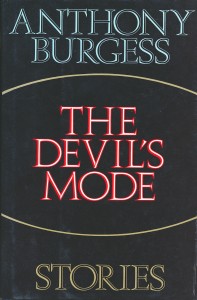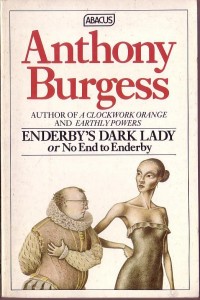Anthony Burgess and Shakespeare
This resource examines some of the ways in which Anthony Burgess thought about and wrote about one of his greatest inspirations.
- Anthony Burgess and Shakespeare
- Burgess and Shakespeare: a brief introduction
- Burgess teaching Shakespeare
- Nothing Like the Sun: a story of Shakespeare’s Love-Life
- The language of Nothing Like The Sun
- Mr WS: Burgess’s Shakespeare ballet
- Fictional Shakespeares
- Burgess’s identification with Shakespeare
- Burgess and Shakespeare: the podcast
Fictional Shakespeares:
Enderby’s Dark Lady, or No End to Enderby (1984)
In the fourth and final novel in Burgess’s comic series about F.X. Enderby, the aging poet has been hired to write the libretto for a musical about Shakespeare and relocates to the fictional Indiana town of Terrebasse. We follow Enderby through his attempts to write and stage the musical — which is substantially the same as ‘The Bawdy Bard’ — and his infatuation with the actress playing the role of the Dark Lady.
Enderby’s Dark Lady suggests identifications not just between Burgess and Enderby as authors of the same Shakespearean musical, but also between Burgess, Enderby and Shakespeare. In the novel the actor who is supposed to be playing the part of Shakespeare is taken ill, and Enderby is persuaded to take over the role. Wearing full Elizabethan costume, Enderby pauses to admire his reflection: ‘Shakespeare looked at Enderby from the mirror and coldly nodded.’
The Devil’s Mode (1989) and A Dead Man in Deptford (1993)
Although there were to be no more large-scale Shakespeare projects in Burgess’s later years, Shakespeare was still to appear as a minor player in several of Burgess’s works. Two Shakespearean short stories are included in The Devil’s Mode: ‘A Meeting in Valladolid’, which dramatises an imaginary debate between Shakespeare and Cervantes in which they fall out over who was the first to create the Don Quixote/Hamlet and Sancho Panza/Falstaff archetypes, and ‘The Most Beautified’, in which Prince Hamlet attends a lecture on aesthetics delivered by Christopher Marlowe’s Doctor Faustus at Wittenberg University. Shakespeare also appears in Burgess’s novel about Christopher Marlowe, A Dead Man in Deptford, as Marlowe had appeared in Nothing Like the Sun and the unrealised film script, ‘The Bawdy Bard’.

Burgess’s Shakespeare was, by his own admission, a reconstructed semi-fictional Shakespeare, taken from a variety of sources, including his own imagination. He made no apology for this and claimed ‘the right of every Shakespeare-lover who has ever lived to paint his own portrait of the man.’ In the absence of firm historical fact, each age, ‘perhaps each decade’, could discover a new aspect of Shakespeare, and ‘every new aspect of Shakespeare will be as true as any other.’
For Burgess, Shakespeare’s humanity, and his skillful representation of what it is to be human, underpinned his skill as an artist. He argues that Shakespeare’s legacy abides because we can all identify with him: ‘We need not repine at the lack of a satisfactory Shakespeare portrait […] He is ourselves, ordinary suffering humanity, fired by moderate ambitions, concerned with money, the victim of desire, all too mortal. To his back, like a hump, was strapped a miraculous but somehow irrelevant talent. It is a talent which, more than any other that the world has seen, reconciles us to being human beings, unsatisfactory hybrids, not good enough for gods and not good enough for animals. We are Will.’
Text by Anna Edwards



